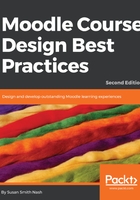
Universal design for learning
Before we start to expand the course, we recommend that you take a moment to plan your course so that it complies with standards and recommendations that have been set to accommodate students' diverse needs and abilities. To do so, we will follow what is referred to as the UDL, which are guidelines that assure accessibility services for individuals with disabilities.
In this section, we will look at legal requirements but keep in mind that the UDL has its roots in ethics, human dignity, and the belief that all individuals deserve to have access to education.
However, in returning to legal frameworks that assure accessibility services to individuals who may have disability issues, let's remember that we must comply with the laws and regulations that have been enacted to provide equal access to them. In the United States, the Americans with Disabilities Act (ADA) (1990) protects the civil rights of individuals living with disabilities and requires academic organizations to make educational programs available to students with disabilities. Do not forget to check for similar laws and regulations in your region since they vary from country to country.
We know that each student has a unique set of abilities and strengths and we also realize that all students possess their own learning styles. So, we need to make sure we design courses that are compliant in the following ways and follow the guidelines set forth in the Higher Education Opportunity Act of 2008; they follow three primary principles as listed:
- Multiple means of representation
- Multiple means of access and expression
- Multiple means of engagement
In an online course, and a learning management system such as Moodle, you have the flexibility to comply with the previous three principles. For a complete guide to the Higher Education Opportunity Act of 2008, you may visit the US Department of Education website at http://www2.ed.gov/policy/highered/leg/hea08/index.html.
Depending on where they live, students with disabilities or special needs may qualify for government-funded programs that provide them with financial support or low-cost assistive technology.
At this point, you may be feeling very nervous and overwhelmed about adhering to complicated rules and regulations. Don't worry; assistive technology has made great strides in the last few years, and many such technologies are very low cost and easy to implement. For example, there are many text-to-voice screen readers and voice recognition programs that convert the spoken word to text. Grand Canyon University has put together an excellent list, which you may find at http://www.gcu.edu/Disability-Office/Assistive-Technology.php.
In addition, many cloud-based applications now incorporate assistive and transformative technologies. For example, if you upload a video or an audio file to YouTube, while you are in Studio mode, you can use Speech to Text to generate a transcript for your audio. You can also use applications such as Speechnotes or Google Speech to Text with your smartphone to record thoughts or a lecture that automatically generates a transcript/text version. Likewise, Text to Speech is often as simple (and can be obtained for free) in applications in the cloud.
Don't forget that reasonable accommodation can be achieved in many different ways, ranging from assistive technologies to something as simple as finding a person who can read to a vision-impaired learner.
The most important consideration when you're planning your course is preparation. Prepare for students with diverse abilities and needs and design a course that builds in the multiple means concept in the Higher Education Opportunity Act of 2008. Remember that it's much more difficult to redesign and retrofit your course than it is to design it well from the very beginning.